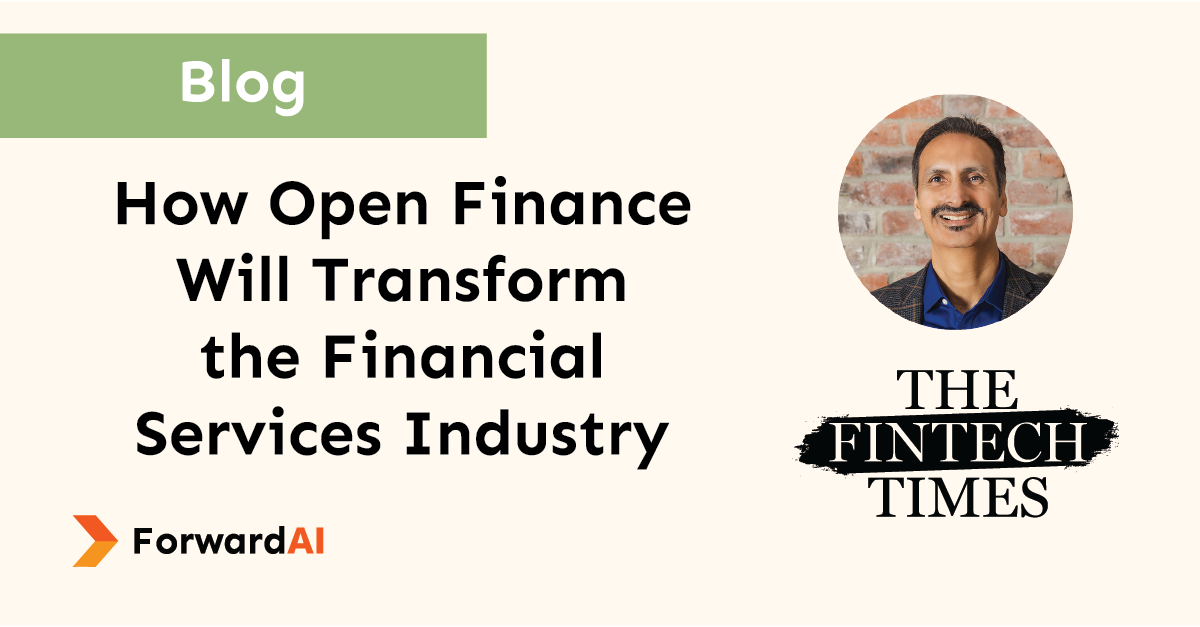How Open Finance Will Transform the Financial Services Industry

Originally published on The Fintech Times
Access to reliable and accurate data is becoming increasingly paramount to the provision of financial services, with KYC being a strong indicator in decision making.
Here in this guest post for The Fintech Times, Nick Chandi, CEO and Co-Founder of ForwardAI, discusses how open finance is being utilised to drive the provision of financial services, and why getting your data ducks in a row will prove to be highly beneficial to business development.
After working within accounting for over a decade, I’ve seen how data is at the centre of the industry and will drive change. The industry is ripe for disruption, and we’re starting to experience a transformation that changes processes and workflows and puts the focus on open data. From Consumer-Directed Finance, PSD2, UK Open Banking, to Consumer Data Right, countries worldwide are beginning to regulate open access to critical data that allows a wide variety of new use cases and data-driven decisions. Open finance is working to democratise financial services.
Isn’t open finance the same as open banking?
The short answer is no. Open banking typically focuses on banking data from various accounts but has evolved into open finance. Open finance is a broader concept that creates more opportunities for lenders, businesses, and consumers. Ultimately, by sharing data, users get more control over their finances.
Open finance is consent-driven data sharing that encompasses data from accounting systems, mortgages, investments, insurance, loans — essentially all the data generated by a business that involves money and finance. This data is shared via third-party APIs with companies looking to provide data-based, value-added services, including lenders and banks. APIs, such as ForwardAI’s Precise API, create a data stream between small businesses and their financial partners. This technology pushes the boundaries of open banking to encompass a wider scope of data for open finance, broadening the use cases and viability within markets.
With access to more data, banks are empowered to offer more products and services to businesses because they now have an inside look at businesses’ financials. Financial institutions want to fully assess the financial strength of a business, which requires reviewing invoices, customer relationships, and suppliers to understand strategies and business models. The most efficient way to gain access to this information is through accounting data, and with customer-permissioned access, lenders can streamline processes and underwrite quickly.
During the pandemic, predicting the financial health of small businesses was difficult for banks and fintechs. Better data from accounting or employee records, for example, would have provided insight into a company’s operations.
That’s where the use cases begin. An example would be a Research and Development (R&D) tax credit for companies that develop, design, or improve products, processes or software. Banks and fintechs can advance funds in the amount of the R&D tax credit, but the only way to assess this credit is to analyse a company’s data to determine the payroll that’s allocated to staff conducting R&D. Providing access to this data so that a company can borrow against the tax credit can improve the company’s liquidity as money can instead be used for its operations or capital investments.
Open finance goes beyond helping a bank identify opportunities for tax credits though. Companies can build better solutions and automatically reconcile accounts anytime a bill is paid with open finance. The impact in the world of payments is significant in that account-to-account (A2A) payments have the potential to eliminate third parties and associated interchange fees.
Along with being cheaper, A2A can be realised in real-time, making it faster than most other payment methods. With open finance, banks and fintechs can access real-time payment data that would help form more fluid financial profiles of businesses.
Open finance has the potential to simplify processes that range from bill payments to mitigating fraud risk. Information is often stored to facilitate transacting. For example, businesses no longer need to share credit card or account credentials with vendors or partners. This type of data sharing is reduced with open finance and as a result, so are occurrences of fraud.
For lenders, context-rich data from accounting systems include details that help them proactively identify their customers’ financing needs. Direct data access removes the friction for customers since they don’t need to upload documents to their banking partners as part of their loan application workflow, or resubmit paperwork when additional funding is needed.
Technology is a significant part of any business’s bottom line, and those that don’t make use of modern technology risk falling behind. I’ve seen how accounting systems can create barriers when businesses don’t provide direct access to their financial partners, and also how opportunities are created when systems are integrated and data is shared.
Today, businesses want to transact seamlessly, they want data delivered and processes completed in real-time. Open finance is a framework that helps banks, among fintechs and other companies, identify opportunities for businesses and helps businesses manage their finances. For small businesses, it has the potential to open massive opportunities and help them compete with their larger peers.
Originally published on The Fintech Times


